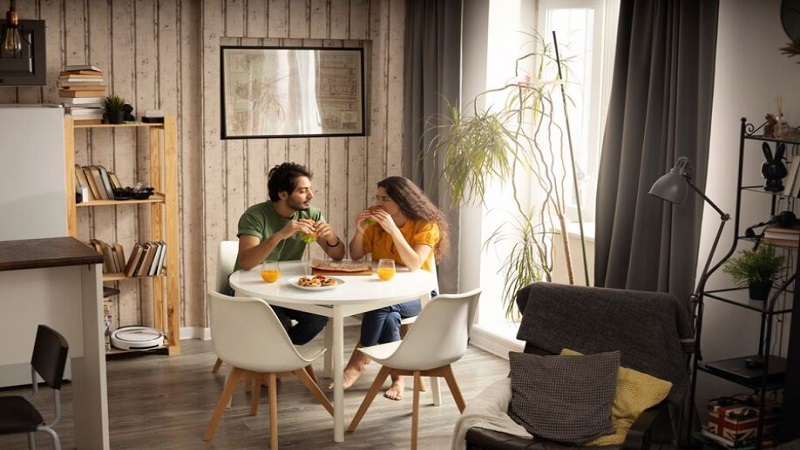1. Upgrade to Energy-Efficient Windows
Windows are a significant source of heat loss and gain in any home. Upgrading to energy-efficient windows can dramatically improve your home’s insulation, reducing the need for heating and cooling. Look for windows with double or triple glazing, low-E coatings, and insulated frames to maximize energy efficiency. These windows can help maintain a consistent indoor temperature, reducing your reliance on HVAC systems and lowering energy bills.
Benefits:
- Improved insulation: Keeps the heat inside during winter and outside during summer.
- Noise reduction: Double or triple glazing helps minimize external noise.
- UV protection: Low-E coatings protect furnishings from harmful UV rays.
2. Install a Programmable Thermostat
A programmable thermostat is an affordable upgrade that can lead to significant energy savings. It allows you to set a heating and cooling schedule based on your lifestyle, ensuring that your HVAC system operates efficiently. Some advanced models can even learn your preferences over time and make automatic adjustments.
Benefits:
- Energy savings: Reduces unnecessary heating and cooling when you’re not at home.
- Increased comfort: Maintains consistent temperatures based on your schedule.
- Remote access: Many models offer smartphone apps for remote control.
3. Switch to LED Lighting
Lighting accounts for a considerable portion of a home’s energy consumption. Switching to LED bulbs is one of the easiest and most cost-effective upgrades you can make. LED bulbs use up to 80% less energy than traditional incandescent bulbs and last significantly longer.
Benefits:
- Long lifespan: LED bulbs can last up to 25 times longer than incandescent bulbs.
- Lower energy consumption: Drastically reduces electricity usage.
- Variety of options: Available in different colors and styles to suit any decor.
4. Add Insulation
Proper insulation is essential for maintaining a comfortable and energy-efficient home. If your home is under-insulated, adding more insulation to your attic, walls, and floors can significantly reduce heat loss. This upgrade is particularly important in older homes where insulation standards may have been lower when built.
Benefits:
- Reduced energy bills: Keeps your home warm in winter and cool in summer.
- Improved comfort: Eliminates drafts and cold spots.
- Environmentally friendly: Reduces the need for heating and cooling, decreasing your carbon footprint.
5. Upgrade to Energy-Efficient Appliances
Replacing old appliances with energy-efficient models can lead to substantial energy savings. Look for appliances with the ENERGY STAR label, which indicates they meet strict energy efficiency guidelines set by the U.S. Environmental Protection Agency.
Benefits:
- Lower utility bills: ENERGY STAR appliances use less energy and water.
- Improved performance: Newer models often have advanced features and better functionality.
- Environmental impact: Reduces greenhouse gas emissions.
6. Install Solar Panels
For a more significant investment, consider installing solar panels. Solar energy is a renewable and sustainable source of power that can drastically reduce your reliance on traditional energy sources. While the initial cost can be high, many government incentives and financing options are available to make solar energy more accessible.
Pairing your solar panels with a home solar battery storage system allows you to store excess energy generated during the day for use at night or during outages. This maximizes the efficiency of your solar setup and provides greater energy independence.
Benefits:
- Reduced energy bills: Generates your electricity, reducing or eliminating utility costs.
- Increased home value: Solar panels are an attractive feature for homebuyers.
- Environmental benefits: Produces clean, renewable energy.
7. Seal Air Leaks
Air leaks can occur around doors, windows, and other areas where different building materials meet. Sealing these leaks with weatherstripping, caulking, or spray foam can improve your home’s energy efficiency by preventing drafts and heat loss.
Benefits:
- Improved comfort: Eliminates drafts and maintains consistent indoor temperatures.
- Energy savings: Reduces the need for heating and cooling.
- Cost-effective: Inexpensive upgrade with significant impact.
Conclusion
Investing in energy-efficient home upgrades not only helps reduce your environmental impact but also saves you money in the long run. Whether you start with small changes like switching to LED lighting or make a larger investment in solar panels, every step toward energy efficiency contributes to a more sustainable future. By choosing the right upgrades for your home, you can enjoy increased comfort, reduced utility bills, and a positive impact on the environment. For more insights and tips on home upgrades, visit FameBlogs.
